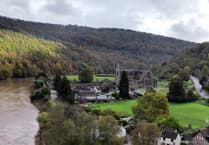Impressive Church Spires
It was a visit to Salisbury that made me realise just how special a church spire is as a landscape feature, added as an impressive symbol of the skill of medieval architects. Soaring high above their surroundings these elegant pointers to the sky not only mark the location of a village, town or city, but are also a symbol of wealth and prestige, for they would have been very costly to construct.
As I drove towards Salisbury, the sight of this 404ft spire dominated my thoughts, even though the city was still some distance away and I remembered reading that this is one of the tallest medieval churches in the world, only surpassed by Strasbourg Cathedral which is 39 feet taller.
I decided to take the ‘Tower Tour’ which was led by a knowledgeable guide and climbed the 332 steps of a stone spiral staircase to a vantage point at the top of the tower, 218 feet above the ground. From there I was not only able to enjoy a panoramic view, but also gaze up the interior of the spire to see its internal construction and the medieval scaffolding that is still intact.
When completed in 1320 the spire required the addition of buttresses, arches and tie irons to keep it intact. Then in 1668 the architect Christopher Wren designed reinforcing beams which ensured its survival.
Lincoln Cathedral’s 525ft spire on the crossing tower was for 238 years the tallest spire in the world, until it collapsed in 1548. Salisbury Cathedral’s spire then became the tallest church spire in the British Isles.
On returning to Monmouthshire I decided to give consideration to the church spires that we have in our county. The tallest one is at St Mary’s Church in Monmouth which rises in three stages from a substantial tower built in Old Red Sandstone during the 14th century.
The spire, soars to a height of 200ft, and on its top is a gilded cockerel weather vane. It was damaged by a lightning strike in 2007 and taken away to be restored. The top 18ft section of the spire was replaced in 2010, as well as the restored cockerel. It is a problem, that due to their height and structure, church spires are particularly vulnerable to damage caused by high winds and torrential rain. Repairs are very costly because of the cost of erecting scaffolding and the specialist work that has to be undertaken by stone masons.
This elegant spire in Monmouth certainly dominates the town and it was much admired by the Newport historian Fred Hando who once eloquently remarked:
‘St Mary’s spire, to me, is sweetly satisfying. A spire is of course a breath in stone – a prayer aspiring – and although Monmouth spire is but half the height of its great contemporary at Salisbury, its uplifting influence is felt along every approach to the town.’
A few miles further south, I made my way to the village of Trellech which is situated 800ft above sea level in a saucer like depression at the top of a hill on the road to Chepstow. The spire of this large church, dedicated to St Nicholas, is clearly seen from the approach in all directions.
In 1792 the tower collapsed during a storm and was rebuilt, including the 160ft spire which provides an elegant pointer to the location of Trellech and is visible for many miles around.
In Llantilio Crosseny, I photographed the spire of St Teilo’s Church which stands on a 12th century central tower and was added in 1708-9, when the bell chamber was strengthened for a new peal of six bells (now eight). It is a broach spire covered in shingles which makes it unusual and a striking feature in the landscape.
St Nicholas’s Church, Grosmont is a 12th-13th century building designed by a French architect and is crowned with a central octagonal tower which was added in the 14th century. It was surmounted by a splendid spire in 1709.
In 2009 the church closed for 9 months while repairs were carried out to the leaning spire and leaking roof at a cost of £25,000.
Christchurch, Ebbw Vale. Is known as the ‘Cathedral of the Hills’ and its lofty spire really dominates the town. The church was built in 1860-61 by the Ebbw Vale Iron Company to the design of John Norris of London. Only the lower stage of the tower had been built and this was completed with a spire to the original plan by Kempson and Fowler in 1891. This tall slated spire soars to a height of 176 feet.
St Mary the Virgin at Nash, is a church that belonged to the long vanished Goldcilff Priory in 1349, and Is known as the ‘Cathedral of the Moors’, although the people of Magor and Peterstone also used to give the same name to their churches !
The tower with its tall octagonal spire dating from the 1500s is a landmark for many miles around and was once the tallest structure on the Levels, but is now dwarfed by giant wind turbines.
Where the spire springs from the tower, the joint is screened by a charming stone balustrade. Buttresses support the tower and nave on the north side. A mark on the tower indicates the height to which the Great Flood rose in 1606.
The shortest spire in Monmouthshire is on Llanelen Church, which was built by the Normans in the 12th century, although very little of its original form has survived, having been altered by John Prichard in 1850-1. He added the unusual Victorian Neo Gothic bell tower at the west end and although it is quite elegant with crocketed pinnacles and a short spire, it is hardly in keeping with this ancient building.
Spire is an interesting word which may have originated from old Saxon for spear, and a very slender spire certainly represents a spear. It has also been suggested that the word is derived from ‘spir’, an old English word meaning a sprout, shoot or stalk of grass. Another suggestion is that it comes from the Latin ‘spinus’ meaning ‘thorn’.
Someone once said that the addition of a spire symbolises the heavenly aspirations of the church builders, as well as providing a spectacle of extreme height. Well, we would certainly feel deprived if we did not have any spires in our county.
While we do not have very many church spires in Monmouthshire, the ones that I have featured are certainly impressive and give special quality to our landscape, so they should not be taken for granted or ignored. We certainly cannot compete with Norfolk which with over 650 churches can claim to be the greatest concentration of churches in the world and accordingly, the flat landscape is widely dotted with medieval church spires.




